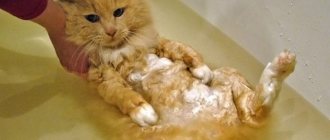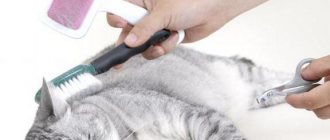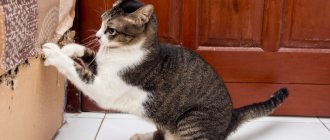Photos of cats walking or even traveling are becoming increasingly common on social networks. Many people wonder: is it necessary to walk a cat? Is it safe? We answer: it is not necessary to walk with your cat. But if you have such an opportunity, and the cat shows interest in the outside world, then you can go for a walk. The main condition is that it must be safe.
Should I go for a walk?
There is no exact answer to this question. Everything is individual: for some pets it is enough to sit by the window or on the balcony, while for others it is vitally important to stay in the fresh air (especially for cats living in country houses where the street is accessible at any time).
To make a decision, you need to understand the physiology of cats. These are territorial animals, ready to fight for their possessions. They have no need for daily travel, so even just five minutes outside the house can result in stress and panic.
Description of the Bengal cat breed, its character, behavior and color features
When getting a kitten, the owner must clearly understand whether his household will go for walks or whether he is destined to become a completely domestic animal. Remember that not all breeds are great for outdoor conditions. For example, Sphinxes do not have hair, which means that the sun's rays and frosty wind will have a detrimental effect in both cases.
We must not forget about the many dangers. Packs of stray dogs, highways and knackers are not a complete list of what a domestic cat may encounter. How many diseases can a mustachioed purr pick up if you let him out on his own without vaccinations? You can write a separate article about this.
The cat walks on a harness
So can you walk cats or not?
Scientists cannot give a definite answer, but it is worth noting that such an event will make your pet happier, not to mention the variety it will bring to its life. Daily walks can become something of a sport for cats for their owners: they will help keep the house purr in good shape and improve physical health. In addition, this is a way to experience new sensations unknown to the pet until now. For example, in the summer the kitty will feel freedom and will be able to run after insects or lie on the grass or sand under the warm sun. Constant walks will make your pet more resilient, not to mention strengthening the respiratory and nervous systems.
In winter, the situation is different due to low temperatures, but this does not mean that walking is prohibited. In winter, it is very cold and damp outside, so it is recommended that you first gradually accustom your cat to low temperatures and snow. But, if the cat’s health does not allow him to stay outdoors for a long time, then a ten-minute stay on the balcony will be enough for him.
How often is it allowed to go outside?
And here it is impossible to say for sure. Some people prefer to provide access to fresh air several times a week, and some owners give complete freedom of action by opening the window (if they live on the ground floor).
Independent breeds, such as the Pixiebob, decide for themselves when to leave and by what time to return to their native lands.
In urban conditions it is much more difficult: there are more risks and a greater likelihood that your pet will get lost (or will be taken by caring residents). In large populated areas, it is not recommended to let cats walk on their own. It is advisable to walk in a harness (collar), where all movements of the ward are controlled by its owner.
How cats prepare for cold weather
Cats are not as sensitive to temperature changes as humans, thanks to their fluffy and thick fur coat.
It’s no secret that cats gain several kilograms of excess weight during the winter. In this case, owners do not need to sound the alarm and put their pet on a strict diet.
In this way, the animal prepares itself for winter, and does this on a subconscious level, thanks to genetic memory, when cats still walked on their own and were forced to take care of themselves.
All cats gain several kilograms of excess weight during the winter.
The fur of these creatures also becomes a little thicker and longer in winter and, remarkably, cats practically do not shed in winter.
Another interesting fact is that cats rarely bathe in winter, and this is due to the fact that wet fur is unable to protect them from the cold.
At what temperature can a cat walk outside?
Cats are one of the hardiest animals
, besides, these creatures live on almost all continents, so most of them are perfectly adapted to the cold climate.
Most cats tolerate cold climates well.
Thick wool and dense undercoat perfectly protect animals from cold and frost and thanks to them the cat almost does not freeze.
Extremely negative temperatures
But don't think that a cat can survive in extreme subzero temperatures.
If she stays in the cold for a long time at minus twenty degrees, then this can end disastrously for her: the animal will freeze its paw pads and ears, which are almost devoid of fur.
A cat cannot survive in extremely low temperatures!
Unfortunately, not all cats are lucky enough to have a home and loving owners. Homeless animals are forced to survive in the winter, taking refuge in hallways, basements or abandoned houses.
As a rule, a cold cat will instinctively look for the warmest place in the house, for example, near a radiator or electric fireplace. Many animals can crawl under a warm blanket or blanket.
Do I need to wash it after?
Felines are clean creatures and can take care of themselves without human help. But in some cases it is better not to wait until the cat licks itself.
In case of heavy contamination
You cannot do without bath procedures if your furry purr gets very dirty. Everything will go without problems with a pet accustomed to water. But without preliminary preparation, the whole process will be complicated by the aggressive behavior of the cat, who wants to get rid of the torment as quickly as possible.
With little
If the situation is not so critical, then you can do without a bathroom. It is enough to wipe the paws and all dirty places with a cloth soaked in warm water.
By what means
The owner's choice should fall on special hygiene products for cats. These are shampoos and conditioners for wool. An alternative option is baby shampoos. If the degree of contamination is low, you can rinse the coat with warm water.
A cat is bathed in a sink
Paw treatment
Paw hygiene is an extremely pressing issue for all pet cat owners. After all, a ward can get dirty not only during a walk, but also after visiting a tray with low-quality filler. We offer two options for washing paws.
- The easiest way is under warm running water in the sink.
- Take the pet in your arms so that the paws are free and there is no possibility of scratching the person or trying to get free. Then the paws are washed under the shower (low pressure).
From childhood, accustom your pet to water and bath procedures. In the future, it will be much easier to wash the cat after walking outside.
Precautions when walking
When deciding to walk a domestic cat, you must take into account the maximum number of risks.
Try to observe your pet’s behavior in familiar conditions; believe me, you will learn a lot about the cat’s interests and fears. Safety rules include predicting the reaction of the ward. For example, do you know how a cat will react to an unexpected loud sound? In outdoor conditions, a four-legged animal may be frightened by the noise from a car, the screams of children, etc. It is to study the reactions of the ward that you need to carry the cat in your arms for the first few walks.
While walking, you may encounter a dog that may react aggressively to the cat. Exactly what to do must be decided depending on the situation. If you see that the dog intends to attack, do not keep the cat on a leash, but rather, push/throw it towards a tree. If the dog is small, pick up the cat in your arms and turn your back to the aggressor. Again, to avoid such situations, it is better to take a carrier for a walk.
Aggressive cats are more decisive than dogs, and if they decide to start a fight, it is not so easy to reduce the temperature. It is optimal to scare the aggressor by pretending that you are going to throw a stone. You can pick up a stick and hit the ground with it. Water, which can be sprayed on the aggressor directly from the bottle, is an excellent deterrent. If there are several aggressive cats and they are defiantly defending the territory, pick up the pet. Cats do not view people as territorial competitors, and if you calmly move away from the place of conflict, the aggressors may accompany you, but they will not attack.
You should not walk your pet without vaccinations because the streets are full of sources of viruses. Don’t forget that your pet must be treated for fleas and ticks, and if you walk outside, then treatment must be done at least once every 3-4 months. Prevention of worms is carried out according to a schedule, but despite this, strictly monitor the cat on the street; it should not go near landfills, garbage, feces of other animals, etc.
It is unwise to walk your cat in winter. In frosty weather, four-legged animals constantly look for sources of warmth and sleep peacefully, curled up in a ball. Walking through snow, cold wind or wet ground will clearly not bring pleasure to your pet. Of course, there are traveling cats that accompany their owners along mountain ranges and conquer the waves, but this is more an indicator of a person’s lifestyle than the desires of a four-legged cat.
The most serious danger is associated with the loss of an animal. If you accustom your cat to a harness, the likelihood of such an incident is small, but experience shows that it exists.
- Accustom your cat to a light collar and equip it with an address tag, capsule, or sign. This collar should never be removed, except for a few hours in the evening, to avoid kinks in the fur. If you use the capsule, be sure to write that there is a guaranteed reward for the cat's return.
- Chip your ward - if he is found and taken to a veterinary clinic, they will find you based on the chip data.
- Do not let the cat off the leash, do not leave it under the store, do not hand it over to the wrong hands, even temporarily.
If the cat still runs away/gets lost, the best chance of returning the loss is to act in hot pursuit:
Stay at the place of loss or within sight of this place for at least 40 minutes - perhaps the cat will return in its tracks. Cats do not run without looking back, even if they are very frightened; most likely, your loss is lurking within a radius of 150–200 meters, but the pet will not respond - it is scared. Leave any item of yours (maybe a piece of clothing) at the place where you lost it and start moving in a circle, expanding the radius. Carefully inspect basement crawl spaces, bushes, trees, look under cars, benches, concrete slabs, heating pipes and any other “secluded places”
It is better to involve friends in the search, since it is important to go around the perimeter of all nearby buildings and structures. If you are in a residential area, you need to include all entrances and basements in your search plan. As soon as possible, start posting missing pet notices. If the first search operation fails, you need to try again as soon as it gets dark
Cats usually feel more self-conscious during daylight.
Preparation
We have discussed all aspects that require special attention. Now we begin to prepare for the walk itself.
Vaccination and treatment against parasites
Pets cannot be taken outside without vaccinations. Even a strong immune system cannot cope with serious diseases. Unfortunately, many owners believe that their place of residence is safe, which means they don’t have to spend money on things like vaccinations and anthelmintic drugs. However, just walking on the grass, a cat can pick up fleas, ticks and even helminths!
By ignoring vaccination and treatment against parasites, the owner jeopardizes not only the health of the animal, but also the health of his family members. Our little brothers can contract many dangerous diseases if they are not given routine vaccinations.
Residents of the southern regions should be especially attentive to the issue of vaccination. The tropical climate (or rather, high levels of humidity) is a favorable environment for various viruses and bacteria, for example, leptospira, which causes leptospirosis. If the owner plans to spend a vacation by the sea, taking the cat with him, it is necessary to check with the veterinarian what additional vaccinations may be needed.
Collar
Cat collars serve a certain practical purpose. For example, this is a necessary accessory at exhibitions or while walking. You can hang an address tag on the attribute in case your pet gets lost. Reflective collars help you find your pet in the dark.
What types can be found on pet store shelves:
- with GPS navigator;
- with a bell and other decorations;
- decorative (for exhibitions and photo shoots);
- antiparasitic.
Walking a cat on a leash and harness
Leash
In urban conditions, walking a cat is strictly on a leash. Walking with a cat is completely different from going outside with a dog.
To control all movements you need a strong leash. Without it, the owner will not be able to provide his household with a safe stay on the street outside the home.
This accessory is not necessary if the pet lives in a private sector and has constant access to the street, i.e. prefers to walk on his own.
Harness
Purebred individuals regularly attend regional and international exhibitions. For the safety of transportation and control of the pet, ammunition is purchased.
A harness is the best option for both outdoor walks and long trips. With its help, the owner can control the cat. Few mustachioed purrs know commands and do not run away from their owner in search of adventure.
What makes the accessory unique? It is made of special thin straps that wrap around the body behind the shoulder blades and have a fastener at the level of the back/chest. At the same time, the design does not create uncomfortable sensations and does not provoke a stressful state.
Let's look at the harness models:
- in the form of a vest (mesh material allows the skin to breathe);
- with an additional strap at neck level (considered the most reliable);
- standard (straps).
Carrying
The most popular and safest option for transporting a cat on long trips. There are different types of carriers: from standard plastic to backpacks with individual design solutions. There are models similar to suitcases on wheels!
Carrying is an important and necessary attribute of any owner of a furry pet. Not a single railway or air company will allow a passenger with a pet to pass without a special transport bag.
Stress
All cats experience negative experiences on their first walks. This is fine. If you sat inside four walls all your life and didn’t know that there was a world around you, you would be scared too. In addition, cats have a heightened sense of hearing and smell, and therefore new sounds and smells of the street seem stronger to them than to us, which is also frightening and stressful at first. But over time, everything changes - and the cat, who hated the street, suddenly begins to love it, because he understands: it’s interesting, it smells nice, it gives new vivid impressions.
With the right approach, which starts with taking the cat in a carrier or in a special space backpack out into the yard for 5 minutes, almost any animal can be taught to love walks. To do this you will need from 1 to 10 outputs. But there always remains a small percentage of those who are against it, even despite regular appearances. It’s probably better to leave them at home and not force them: if the animal experiences negative stress every time during a walk, this will not bring anything good - then let it breathe the air while sitting on the windowsill.
How to dress and train
First, the cat must become familiar with the item purchased for him. This way the pet will be convinced that the attribute is safe and does not pose a threat to life. For several days, the owner allows him to sniff and inspect the equipment.
The first attempt to put on a harness or collar is made only after preliminary familiarization with the accessories. All processes take place in a calm atmosphere. Sudden movements are completely excluded. Experienced felinologists recommend combining training with feeding: first put on the equipment, then feed the pet. This way, positive associations with walking attributes are quickly established.
At first, the cat walks around in full “outfit” for several minutes a day. Gradually the time increases. Please note that the harness and collar should not be too tight. One finger should be placed between them and the animal's body.
The equipped pet experiences new sensations. They will not always give him pleasure. He needs to be distracted with active games or treats.
Kittens learn the fastest at 2-3 months of age. Until five months, the baby “walks” dressed only at home.
How to walk your pet correctly
If you decide to introduce your pet to the outdoors, you need to learn the basic rules for walking cats, recommended by experienced breeders:
- It is better to take walks away from the highway (the noise of cars can cause stress in your pet);
- The cat should be kept at a far distance from stray cats and dogs;
- It is necessary to ensure that the pet does not catch or eat mice and birds in any form, and it should also be protected from eating unfamiliar food.
We know very little about the time of the appearance of the first domestic animals; there is practically no confirmed information about them. There are no legends or chronicles preserved about that period of human life when we were able to tame wild animals. It is believed that already in the Stone Age, ancient people had domesticated animals, the ancestors of today's domestic animals. The time when man got modern domestic animals remains unknown to science, and the formation of today's domestic animals as a species is also unknown.
Scientists assume that every domestic animal has its wild ancestor. Proof of this is archaeological excavations carried out on the ruins of ancient human settlements. During excavations, bones were found belonging to domestic animals of the ancient world. So it can be argued that even in such a distant era of human life, domesticated animals accompanied us. Today there are species of domestic animals that are no longer found in the wild.
Many of today's wild animals are feral animals caused by humans. For example, let's take America or Australia as clear evidence of this theory. Almost all domestic animals were brought to these continents from Europe. These animals have found fertile soil for life and development. An example of this is hares or rabbits in Australia. Due to the fact that there are no natural predators dangerous for this species on this continent, they multiplied in huge numbers and went wild. Since all rabbits were domesticated and brought by Europeans for their needs. Therefore, we can say with confidence that more than half of wild domesticated animals are former domestic animals. For example, wild city cats and dogs.
Be that as it may, the question of the origin of domestic animals should be considered open. As for our pets. The first confirmations in chronicles and legends we meet are a dog and a cat. In Egypt, the cat was a sacred animal, and dogs were actively used by humanity in the ancient era. There is plenty of evidence for this. In Europe, the cat appeared in large numbers after the Crusade, but firmly and quickly occupied the niche of a pet and mouse hunter. Before them, Europeans used various animals to catch mice, such as weasels or genets.
Domestic animals are divided into two unequal species.
The first type of domestic animal is farm animals that directly benefit humans. Meat, wool, fur and many other useful things, goods, and are also used by us for food. But they do not live directly in the same room with a person.
The second type is pet animals (companions), which we see every day in our houses or apartments. They brighten up our leisure time, entertain us and give us pleasure. And most of them are almost useless for practical purposes in the modern world, such as hamsters, guinea pigs, parrots and many others.
Animals of the same species can often belong to both species, both farm animals and pets. A prime example of this is that rabbits and ferrets are kept at home as pets, but are also bred for their meat and fur. Also, some waste from pets can be used, for example, the hair of cats and dogs for knitting various items or as insulation. For example, belts made of dog hair.
Many doctors note the positive impact of pets on human health and well-being. We can notice that many families who keep animals at home note that these animals create comfort, calm, and relieve stress.
This encyclopedia was created by us to help pet lovers. We hope that our encyclopedia will help you in choosing a pet and caring for it.
If you have interesting observations of your pet’s behavior or would like to share information about some pet. Or you have a nursery, veterinary clinic, or animal hotel near your home, write to us about them at , so that we can add this information to the database on our website.
Proper walking
For a safe walk, the owner must fulfill the following conditions:
- choose a deserted and quiet place;
- the cat walks under constant supervision and strictly on a leash;
- during the entire stay on the street there are no various irritants (other animals, cars, large crowds of people).
The environment can cause stress and panic in the patient. Shrouded in fear, he will do everything to break out of his shackles and find the safest possible place.
Pulling on the leash is useless
Which cats are contraindicated for winter walks?
When a pet asks to go outside in winter, many owners wonder at what temperature do cats freeze and is it worth letting them out for a walk when the thermometer has dropped below zero?
It all depends on the length of the coat and the breed of the animal. Maine Coons, Norwegian Forest cats and Siberian cats have luxurious coats and a thick undercoat that perfectly protects them from the cold. Representatives of these breeds feel great outdoors even at 15-20 degrees below zero.
Hairless cats - bambino, sphinxes, Ukrainian lefties freeze in winter, even if they are in a warm house, so it is strictly forbidden to walk them in winter.
Particular attention and care should be given in winter to small kittens, pregnant cats and elderly pets, as they tolerate cold extremely poorly and can even die from hypothermia. To make winter walks safe for your cat, it is recommended to walk your pet under supervision or on a leash.
This way, the owner can be sure that the animal will not get lost or die if it finds itself outside in severe frost.
To make winter walks safe for your cat, it is recommended to walk your pet under supervision or on a leash. This way, the owner can be sure that the animal will not get lost or die if it finds itself outside in severe frost.
What dangers await a cat in a metropolis?
A kitten, by coincidence, born in a basement or alley, is forced to fight for its existence from birth. But for domestic cats, life is initially different. From a kitten that was nursed from birth, like a human child, grows into a pampered animal, poorly adapted to life on the street.
This is why some veterinarians are categorically against walking cats within city limits, even if you have a park area next door. Any movement of an apartment cat to an unfamiliar place can cause stress and a panic attack in your pet. And if suddenly an animal, in such a state, breaks out and runs away, it will, with a high degree of probability, face inevitable death either under the wheels of a vehicle or from the teeth of stray dogs.
It is not advisable to take aggressive and very cowardly animals outside;
Unvaccinated cats and kittens under 5 months;
Adult animals in old age, especially if this has not been done before;
If the cat is in heat or pregnant;
Animals weakened by disease.
Leash for your pet
If you are still concerned about the variety of life of your four-legged pet or you want to spend more time with your adored pet, experienced breeders recommend using a leash or harness for street walks.
To protect your animal, yourself and those around you while walking, cat lovers have come up with a special harness system that fits on your pet’s body. The straps wrap around the purr's neck and front paws. This entire system is located above the animal’s shoulder blades. The leash is also attached here. When choosing a harness, you should know that one finger and no more should fit between the cat’s body and the straps. Otherwise, your pet will simply wriggle out of the straps and run away.
How to train a cat to wear a harness
It is very important not to frighten the animal or cause discomfort when putting on the harness. Let your pet first get acquainted with an unusual object, play with it, smell it, get used to its smell
Then, put the harness on the cat every time she feeds and leave it for a while. Next, after fastening the leash, walk around the apartment with your ward and evaluate his reaction. And only when you understand that your pet is absolutely calm about putting a harness and leash on him, you can try to go outside with him.
How to walk a cat correctly
If you have firmly decided that there is no point in your four-legged charge leading the life of a recluse and have already accustomed him to a leash, then the time has come for his first walks. It’s good if for this purpose you choose the park area closest to your house, in which you will also have to find the most secluded place for a walk with your pet (dogs walking past and nearby vehicles, just like a large crowd of people, can frighten the animal). When you reach your destination, do not rush the cat or forcefully pull it along with you. The pet needs time to get comfortable and get used to an unfamiliar environment, after which it will lead you in the direction it needs. Despite the fact that most cats still lead an exclusively indoor lifestyle, it doesn’t hurt to accustom your kitten to the outdoors. This will not only diversify its daily existence, but will also come in handy in those moments when you have to take your cat to the veterinarian or to the country.
What to do to prevent escape
There is only one solution - take him out strictly on a leash and do not let him go under any circumstances. Any noise can frighten the pet and it will immediately begin to look for a secluded place to wait out the danger.
Cats instinctively try to climb up when threatened. This means that in a stressful situation the pet will climb onto the owner’s head or break free to jump onto a tree (as high as possible!). Unfortunately, not every individual can descend on its own. In such cases, you have to call rescuers.
Cats hate any embarrassment!
Of course they hate it!
They hate a lot of what life next to a person forces them to do. But still not so much as not to put up with it for the sake of the benefits that coexistence brings them. For example, delicious food. Did you guess it? Walking on a leash is an element of training, and correct behavior must be rewarded. Praise your cat for her calm and indifferent attitude towards the harness and leash, give her treats, and rejoice in her successes. And when she truly feels the joy of walking, she will love her leash and will express impatience when it is in your hands.
Movement on a leash
First, make sure that the walking area is quiet and calm. Nothing can distract your pet and the likelihood of other animals appearing is minimized. This is very important, especially if the purr goes outside for the first time in its life.
All actions of the owner must be smooth. Harshness and raised voice are excluded. The owner gives the cat the opportunity to explore the environment and adapt to new conditions. The ward will begin the walk, and the person will only have to control the trajectory of movement so as not to go into an area where there is a potential danger.
I've run out of energy, it's time to go home
What breeds don't need to go for walks?
It is extremely undesirable for hairless individuals to leave the house for the opportunity to enjoy nature. The Don Sphynx, Ukrainian Levkoy, Minskin, Peterbald and their relatives have no fur, and their skin is delicate and sensitive. Therefore, in hot weather they are highly likely to get a thermal burn, and in winter - frostbite and related diseases.
First experiments
Experienced owners recommend doing the following: take the cat outside in a carrier bag so that there is an opportunity to explore the environment from a “safe distance.” And only then provide the opportunity to walk on a leash. This is how the owner will be able to study the behavior of his cat outside his usual apartment and accurately determine whether the pet needs regular trips outside.
Having chosen the most suitable area, the pet is carefully lowered to the ground. Don’t be distracted by your phone or conversations with friends, control every step and surroundings, because at any moment a stranger or a dog without a leash may appear. Give the cat the opportunity to satisfy its curiosity, do not pull it away from every bush (such actions can cause injury to the animal).
Make sure that your household does not pick up anything from the ground. Do not let him near the carcasses of small rodents or birds. Avoid contact with other cats, which may provoke aggression. Don't let it go too far.
The first walk should not last longer than 10-15 minutes. Only in the future is it possible to increase the time to 30-40 minutes, when the purr adapts to new conditions. Individuals on their own determine the duration of their travel.
And at the dacha you can without a leash
What should you remember while walking?
The cat must always be on a leash. A beetle flying by can awaken your pet's inner predator, which will chase its prey. So the cat can run away in an unknown direction and get lost. In addition, when the cat is on a leash, you can always make sure that it does not eat anything from the ground.
Walking a cat is not the same as walking a dog. Of course, a cat can also be trained to walk nearby, for example, using clicker training. But in most cases, it is not the owner who walks the cat, but the cat who walks the owner. Somewhere the pet will stop to smell the flowers, somewhere to look at the bird. At some point, you might want to go hunting for a bug together. Cats rarely walk in the direction indicated by their owner. Usually the opposite happens.
Use a leash to control your cat. You can restrain your pet so that he does not climb into a ditch or sniff other people's feces. Cats are very smart, your pet will quickly understand when you are against some of his actions. Remember that you need to pull it gently so as not to cause discomfort or pain to your pet.
Always be alert. If your pet suddenly freezes and stares somewhere, pay attention to this. What could have caught his attention? Often your cat will hear the threat before you do. The threat could be a car or a dog.
When walking, always look around and try to predict what might scare your pet. Make sure there are no off-leash dogs around. The less stress your cat experiences, the more fun she will get from the walk.
For long walks over long distances, a cat backpack will come in handy. This is both a safe shelter and an opportunity to relax.
What not to do
Highly not recommended:
- walk near highways;
- stay in places with large crowds of people;
- allow everyone to pet the cat;
- be in a place where dogs are taken out;
- going out at night;
- sudden movements towards the animal;
- raised voice, shouting, swearing;
- force to walk;
- put on equipment without prior preparation.
In what cases is walking contraindicated:
- in case of identified diseases;
- after operations and during the recovery period;
- age over 7-10 years;
- kittens up to 5 months;
- if the female is pregnant or in heat.
Unsterilized individuals can run away from home in search of their other half. The male runs the risk of contracting illnesses; for females, love affairs always end in an “interesting” situation.
Worms and poison
Anything that can get into a cat's mouth on the street is potentially dangerous. Worms are found in the soil and grass, but you shouldn’t be particularly afraid of them. We constantly bring worm eggs home on our shoes, so the cat is already familiar with them in any case. If you carry out periodic deworming, then there is no need to worry. But the food scattered on the ground, poisoned by dog hunters, is worth attention. Never allow your cat to take food from the ground! If a dog can be trained not to do this, then with cats the problem is easier to solve with the help of a leash and your attention.
Equipment for humans
Clothing should be as comfortable as possible. Choose an outfit that you don’t mind getting dirty, because you don’t know what might happen on the street.
Bag
A simple bag will be needed to carry treats with you. You can replace it with a small backpack or a small belt bag. The latter is most often chosen by dog trainers and dog owners when planning to conduct training in the fresh air.
Shoes
Opt for comfortable sneakers or boots depending on the time of year. Avoid heels, flip-flops and other similar footwear, even if the walk takes less than half an hour. In winter, boots that don't slip on ice are perfect.
Costume
A sporty outfit is perfect for spring and summer. Dress so that your clothes do not restrict your movement. Choose equipment that you don’t mind getting dirty or ruined. It is not necessary to buy tracksuits, the main thing is to choose the most comfortable look for walking on the street.
What does the Abyssinian cat breed look like, as well as its colors, character and behavior
Gloves
Whether they are needed or not is everyone’s personal choice. If the cat is prone to aggression or is cowardly by nature, the accessory will help protect against claws. On the other hand, gloves can only get in the way, for example, when you need to get a treat from a bag.
Choosing ammunition
For walks together, you will need a harness and leash. The standard cat leash that comes with the harness can be replaced with an automatic tape measure. Every owner will appreciate the benefits of a self-regulating leash already on the first walk - you won’t have to constantly untangle, unhook, fold, unravel and pull on a dangling leash. Before putting a leash on your cat, you need to make sure that the harness “sits” the way it should: you can stick your index finger under any strap, nothing is pressing or dangling anywhere.
To choose the appropriate harness size, you need to know the circumference of your pet's chest just behind the front paws. The ideal material is nylon, which is strong enough and flexible, does not rub the wool and does not change shape during use. In addition, nylon is easy to wash and retains its original appearance after soaking in water. A cotton cat harness is less durable, while a leather cat harness rubs the fur and presses under the weight of the material.
There are several types of harnesses, but the “H” and “8” models are most suitable for cats. The “H” variation consists of two rings connected by a strap (sometimes by two straps for greater security, the second strap is parallel to the first, but is located below).
From the picture below it becomes clear how to put a harness on a cat: a ring of a larger diameter is fastened just behind the front paws, a ring of a smaller diameter is fixed around the neck. A strap along the back connects the rings, preventing them from “spreading”.
An infinity- or figure-eight-shaped harness differs from the “H” model in the way the rings are fixed: there is no transverse belt, the rings are connected directly to each other.
There is only one “latch” on this model, so many owners do not understand how to put the harness on a cat. Everything is quite simple: open the lock, put the first ring on the cat’s neck, place the dangling strap around the chest just behind the front paws and snap the lock. A harness on a cat looks something like this:
Both options are quite reliable, but mustachioed impatiens perceive “H” harnesses more calmly. Apparently due to the lack of pressure on the throat, because the transverse strap prevents the tension of the first ring.
The following harnesses are suitable for the most delicate and demanding cats:
No straps putting pressure on the chest or neck, secure fit with wide strips of breathable and lightweight material. Many cats who do not allow themselves to be put on a regular harness not only tolerate such “designs”, but also do not seem to notice the fashionable accessory at all.
What experts say
There is no consensus on whether domestic cats should be bred. Veterinarians and felinologists are divided into two camps, citing many arguments. But if the owner is determined to walk a mustachioed pet, experts recommend preparing in advance:
- find out the nearest veterinary centers;
- prepare a first aid kit in case of emergency;
- undergo routine vaccinations and give anthelmintic drugs;
- castrate/sterilize as a preventive measure against unwanted pregnancy and sexually transmitted diseases;
- make an address book with contact information;
- microchip the animal.











